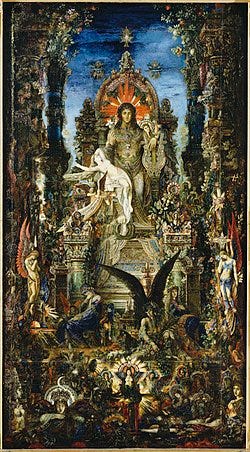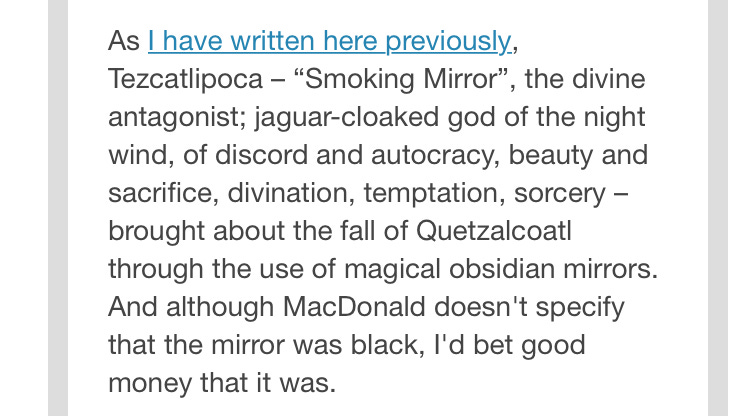"Semele was kept for a more brilliant union...". –Nonnus, “Dionysiaca”, Book 5.
I can only take on one archon at a time, and mine saw me coming —according to his own, untrustworthy, narration— about two generations before I was born. I was expected, I am being enjoyed, and will not be sacrificed in vain; though it is not unlikely I will be scapegoated in due course. All the foreshadowings are present as Leben-motifs. If one intends to last as long as possible, then one must have an ear for these things. I do. An ear and an eye, which is what they may cost you:
I’ve interacted frontally and directly with Mimesis twice, on August 21 of 2021 and February 4 of 2022. No one has described it better than my friend Wayne Chambliss, whose experience with tricksters is at the very least commensurate with mine. He described the thing in Aztec garb, which is secondary (Burroughs would have picked a Mayan arc).
But, assassins that they both are, the focus of this piece is on its colleague, Control —to return to Mimesis, with purpose.
In May of last year, I denounced Control by name —something only one of my readers overtly noted— but other than being able to spot and call him out, I know him —and what he is capable of— largely through Burroughs, whose wife it killed by proxy so as to “motivate” and “formulate” his writing. “I live with the constant threat of possession, a constant need to escape from possession, from Control.”
Burroughs really digs into the issue in his 1975 essay “The Limits of Control”, to which I alluded directly in Covidian Æsthetics. In referring to the UFO/UAP phenomenon, I wrote:
What we are catching glimpses of is what Vallée, and indeed Burroughs—the most American philosopher since James and Peirce—described as Control or the Control System (which, per Burroughs, needs ‘words,’ ‘time’ and ‘opposition’ to unfold). That UFO/UAPs are receptive to ‘call and response’ interaction, for example, that they can be caught-out and lured, is telling for the simple reason that, to remain as Control—in Control—Control must also have a surplus; that is, it must not be so seamless so as to devolve entirely into use. Control is governed, as it were, by its own incompleteness theorem.
Mimesis, which is also a Prince of This World, operates differently (Burroughs noted it too, most obviously in his observance of the latah in Naked Lunch). Its MO is much more akin to that of contagion. Little wonder that it found such a heyday for expression in the past two years, including its promised and overpowering presence in my life. It wants me to know it, to tread on it even.
But the ground it has gained in the past years will not be something it relents easily. Mimesis is fully in the driver’s seat now. My sole defence against this is I have the capacity to see it and resist it within my very private confine, but that won’t make any dents in its progress. I’ll be dead before it is replaced by another archon of similar stature, of which there are a few, but not that many.1
It is the dragon at the start and end of the world —call him Mimesis, Pygmalion, Shakespeare, or any god whose creative prowess or skill was challenged by a mortal (Athena/Arachné, Apollo/Marsyas, the Muses/the Pierides), because whomever challenges a god is challenging Mimesis : “I am not your copy, I am the original.” And every challenger is destroyed in competition by the god they counter, a classic and repeat mimetic triumph.2
But let us return to Control, for which freedom and fear are on an inseparable spectrum. You choose one; or —if given enough time— one chooses you.
Freedom is costly. Fear is too, but it conveniently presents as something you can pay off in instalments (the promise of temporal relief. Mimesis, once lived, offers the exact opposite: a ceaseless, consuming awareness of it —you spot it at every turn, through all of its shapeshifts, in utter impotence). With Control, la morte à crédit seems more manageable than the voyage au bout de la nuit. No one wants to know that much, not constantly.
The freedom vs fear selection plays of course out in the least heroic and flattering of ways. There is a limited —though not necessarily limiting— sense that this is what the struggle between “good and evil” would come down to, specifically regarding Control. So at the same time, this is very obviously not a battle of a moral order, it is a normative struggle; a battle of law, to which one capitulates with minor acts of cowardice, with infinitesimal but additive betrayals; with small, sometimes forgettable, concessions. You don’t say yes. You don’t say no. You gradually accept Control.
It all corresponds, once again, to my aesthetics of expulsion (the tragic, with its implicit risk of expulsion) and invasion (the panic, with its certainty of invasion). The choice is, again, between the abnormal and the informal.3
In Cities of the Red Night,4 Burroughs describes the five different ways the immanentisation of the eschaton can play out, through six cities that could have made Calvino recoil in distaste. To [b(r)]each their own (the italics are mine):
Tamaghis: In which “everything is as true as you think it is and everything you can get away with is permitted.”
Ba’dan: In which “everything is true and everything is permitted.” 5
Yass-Waddah: In which “everything is true and nothing is permitted except to the permitters”.
Waghdas: In which “permission derives from complete understanding”.
Naufana and Ghadis: In which “nothing is true and therefore everything is permitted”.6
The mimetic variant of this is subtle, but no less searing, and it is the one we are now permanently immersed in: “nothing is real, everything is permitted” (aka “This is the West, sir. When the legend becomes fact, print the legend.”)7
So run through the sequence of cities again, in order of reality, not truth. And now, you tell me where we fall. A consideration for those of us still interested in reinaugurating the American frontier. Caveat, domitor.8
Gustave Moreau. Jupiter et Sémélé. 1894-5. Oil on canvas. 213 cm × 118 cm. Musée National Gustave Moreau, Paris.
We will address the nature of these titanic, cosmogenetic forces on another occasion.
The only possible exception I can think of to this rule is Christ, in whom there is, however, no hubris or contest against the Father, and some proof that those whom the gods wish to exalt, they at least don’t drive mad. Everything else is fair game to them. The Crucifixion is no less cruel than the flaying of Marsyas (and the flayed man makes a curious, symbolic appearance in my lecture on Hyperbaroque).
My choice of painting was very careful tonight. Semele is destroyed by beholding her divine lover in his full splendour, but Moreau also filled his canvas with a series of recurring tropes known and useful to us: “At the foot of the throne,” he writes, “Death and Sorrow form the tragic basis of Human Life, and not far from them, under the aegis of the eagle of Jupiter, the great Pan, symbol of Earth, bows his sorrowful brow, mourning his slavery and exile, while at his feet is piled the somber phalanx of the monsters of Erebus and Night….” (the italics are mine: the tragic and the panic are in the room, together, at once).
William Burroughs. Cities of the Red Night. New York: Picador (Picatrix?)
At the time of writing, Ba’dan was claimed by the author to most closely resemble “present day America.” The reader will note this has since changed. The Covidian appears to have moved us to the level of Yass-Waddah; not coincidentally, perhaps, the “female stronghold” of the six.
“Nothing is true and everything is permitted” is also, of course, the original formulation of Hassan-i-Sabbah, the Old Man of the Mountain, to whom I referred expressly in my introductory piece for my Ribbonfarm Recognitions series.
Mimesis plays a critical role here, as all of these cities are enmeshed in a reproductive crisis.
The quip, best known through Ford’s The Man Who Shot Liberty Valance, has a more nuanced story than the one usually told, which can be found here. “Truth” makes an entrance, for one.
It is possible my breakdown will remind some readers of Eco’s 14 pointers on ur (or Eternal) fascism. Future Prudences may indicate I welcome the comparison.






